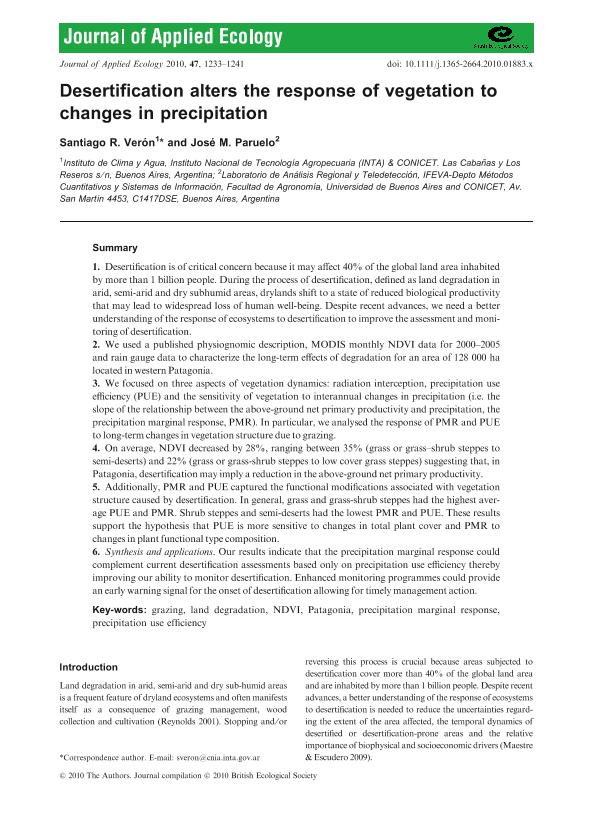Mostrar el registro sencillo del ítem
dc.contributor.author
Verón, Santiago Ramón

dc.contributor.author
Paruelo, José

dc.date.available
2019-03-18T18:51:01Z
dc.date.issued
2010-01
dc.identifier.citation
Verón, Santiago Ramón; Paruelo, José; Desertification alters the response of vegetation to changes in precipitation.; Wiley Blackwell Publishing, Inc; Journal of Applied Ecology; 47; 6; 1-2010; 1233-1241
dc.identifier.issn
0021-8901
dc.identifier.uri
http://hdl.handle.net/11336/71907
dc.description.abstract
1. Desertification is of critical concern because it may affect 40% of the global land area inhabited by more than 1 billion people. During the process of desertification, defined as land degradation in arid, semi-arid and dry subhumid areas, drylands shift to a state of reduced biological productivity that may lead to widespread loss of human well-being. Despite recent advances, we need a better understanding of the response of ecosystems to desertification to improve the assessment and monitoring of desertification. 2. We used a published physiognomic description, MODIS monthly NDVI data for 2000-2005 and rain gauge data to characterize the long-term effects of degradation for an area of 128 000 ha located in western Patagonia. 3. We focused on three aspects of vegetation dynamics: radiation interception, precipitation use efficiency (PUE) and the sensitivity of vegetation to interannual changes in precipitation (i.e. the slope of the relationship between the above-ground net primary productivity and precipitation, the precipitation marginal response, PMR). In particular, we analysed the response of PMR and PUE to long-term changes in vegetation structure due to grazing. 4. On average, NDVI decreased by 28%, ranging between 35% (grass or grass-shrub steppes to semi-deserts) and 22% (grass or grass-shrub steppes to low cover grass steppes) suggesting that, in Patagonia, desertification may imply a reduction in the above-ground net primary productivity. 5. Additionally, PMR and PUE captured the functional modifications associated with vegetation structure caused by desertification. In general, grass and grass-shrub steppes had the highest average PUE and PMR. Shrub steppes and semi-deserts had the lowest PMR and PUE. These results support the hypothesis that PUE is more sensitive to changes in total plant cover and PMR to changes in plant functional type composition. 6. Synthesis and applications. Our results indicate that the precipitation marginal response could complement current desertification assessments based only on precipitation use efficiency thereby improving our ability to monitor desertification. Enhanced monitoring programmes could provide an early warning signal for the onset of desertification allowing for timely management action. © 2010 The Authors. Journal compilation © 2010 British Ecological Society.
dc.format
application/pdf
dc.language.iso
eng
dc.publisher
Wiley Blackwell Publishing, Inc

dc.rights
info:eu-repo/semantics/openAccess
dc.rights.uri
https://creativecommons.org/licenses/by-nc-sa/2.5/ar/
dc.subject
Grazing
dc.subject
Land Degradation
dc.subject
Ndvi
dc.subject
Patagonia
dc.subject
Precipitation Marginal Response
dc.subject
Precipitation Use Efficiency
dc.subject.classification
Ecología

dc.subject.classification
Ciencias Biológicas

dc.subject.classification
CIENCIAS NATURALES Y EXACTAS

dc.title
Desertification alters the response of vegetation to changes in precipitation.
dc.type
info:eu-repo/semantics/article
dc.type
info:ar-repo/semantics/artículo
dc.type
info:eu-repo/semantics/publishedVersion
dc.date.updated
2019-03-08T20:19:49Z
dc.journal.volume
47
dc.journal.number
6
dc.journal.pagination
1233-1241
dc.journal.pais
Reino Unido

dc.journal.ciudad
Londres
dc.description.fil
Fil: Verón, Santiago Ramón. Consejo Nacional de Investigaciones Científicas y Técnicas; Argentina. Instituto Nacional de Tecnología Agropecuaria. Centro de Investigación de Recursos Naturales. Instituto de Clima y Agua; Argentina
dc.description.fil
Fil: Paruelo, José. Consejo Nacional de Investigaciones Científicas y Técnicas. Oficina de Coordinación Administrativa Parque Centenario. Instituto de Investigaciones Fisiológicas y Ecológicas Vinculadas a la Agricultura. Universidad de Buenos Aires. Facultad de Agronomía; Argentina
dc.journal.title
Journal of Applied Ecology

dc.relation.alternativeid
info:eu-repo/semantics/altIdentifier/doi/https://doi.org/10.1111/j.1365-2664.2010.01883.x
dc.relation.alternativeid
info:eu-repo/semantics/altIdentifier/url/https://besjournals.onlinelibrary.wiley.com/doi/full/10.1111/j.1365-2664.2010.01883.x
Archivos asociados
